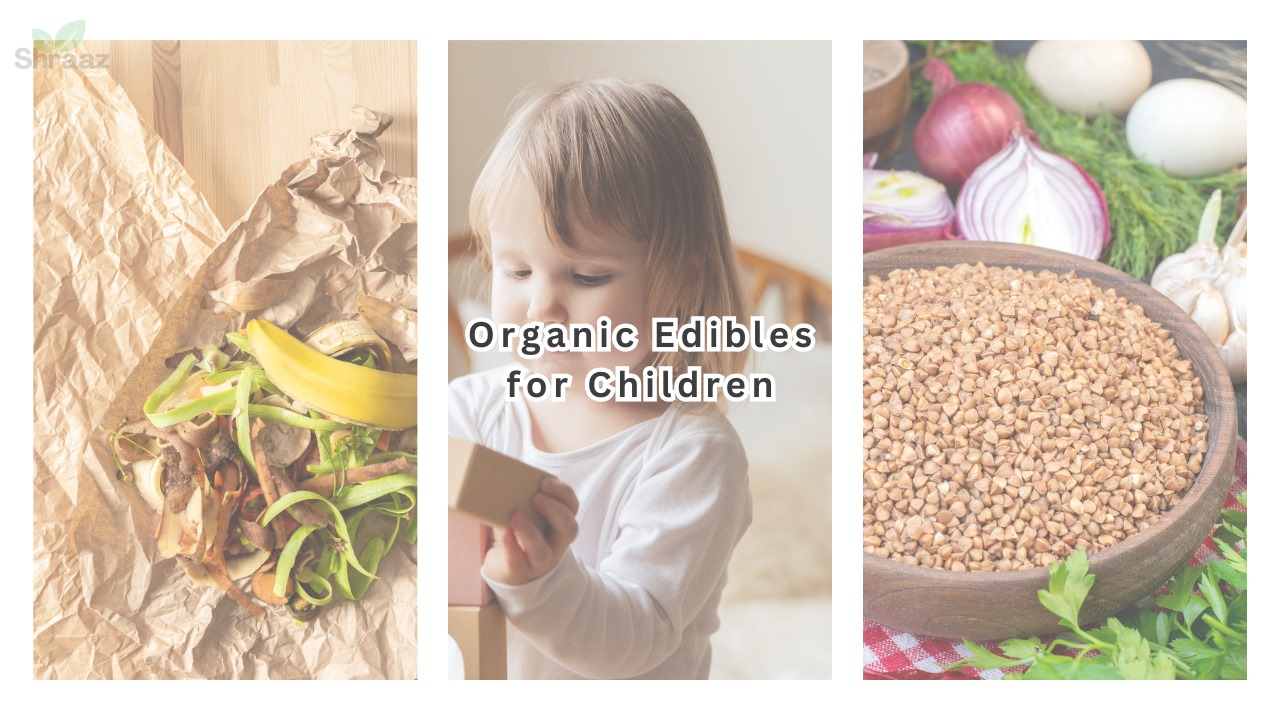Introduction to Organic Edibles for Children
In recent years, parents have become increasingly concerned about what their children eat. The rise of organic foods, particularly organic edibles tailored to children, reflects growing awareness about the potential health benefits of consuming foods free from pesticides, synthetic chemicals, and genetically modified organisms (GMOs). Organic edibles offer a cleaner and more nutritious alternative to conventional foods, making them an appealing choice for health-conscious families.
As the market for organic foods continues to grow, it is essential to understand the benefits and challenges of incorporating organic edibles into children’s diets. This article will explore what organic edibles are, their nutritional advantages, challenges such as affordability and accessibility, and how parents can make organic eating more budget-friendly. We will also discuss organic alternatives to popular processed foods and the role organic foods can play in schools and daycare settings.
For a broader discussion of the overall organic foods beyond just organic edibles for children, check out The Complete Guide to Organic Food/Edibles: Benefits, Characteristics, and Future Trends.
What Are Organic Edibles?
Definition of Organic Edibles
Organic edibles refer to foods produced without the use of synthetic pesticides, fertilizers, or GMOs. These foods adhere to strict agricultural standards set by certifying bodies such as the USDA (United States Department of Agriculture). Organic farming practices emphasize the use of natural methods to maintain soil health and biodiversity while avoiding harmful chemicals that can contaminate food and the environment.
Types of Organic Edibles for Children
There is a wide variety of organic foods available for children, including:
- Fruits and Vegetables: Apples, carrots, spinach, and strawberries are among the most commonly purchased organic produce.
- Dairy Products: Organic milk, cheese, and yogurt are free from synthetic hormones and antibiotics.
- Grains and Cereals: Organic whole grains like oats, rice, and bread are staples for many families.
- Meat and Protein: Organic meat, poultry, and plant-based proteins (like tofu) avoid the use of antibiotics and growth hormones.
- Snacks: Organic snacks, such as granola bars, crackers, and fruit snacks, offer convenient, cleaner options for on-the-go consumption.
Nutritional Benefits of Organic Foods
There is evidence to suggest that organic foods can offer several nutritional benefits compared to conventionally grown foods:
- Higher Levels of Antioxidants: Organic fruits and vegetables often contain more antioxidants, which are linked to lower risks of chronic diseases.
- Omega-3 Fatty Acids: Organic dairy and meat products tend to have higher levels of omega-3 fatty acids, which are essential for brain development and heart health in children.
- Lower Pesticide Residues: According to the Environmental Working Group (EWG), conventional produce can be contaminated with pesticides that may be harmful to children’s developing bodies. Organic produce, by contrast, has lower pesticide residues.
Benefits of Organic Edibles for Children
Health Benefits
The most significant benefit of organic edibles for children is their reduced exposure to harmful chemicals. Pesticides and synthetic additives commonly used in conventional farming have been linked to developmental issues, allergies, and even long-term health problems in children. Organic foods eliminate these risks, allowing children to consume cleaner, more natural products. According to a study published in Environmental Health Perspectives, switching to an organic diet can significantly lower pesticide levels in children’s bodies.
Other health benefits include:
- Reduced Allergies and Sensitivities: Organic foods often contain fewer additives, preservatives, and artificial colorings, which may reduce the risk of food sensitivities or allergic reactions.
- Improved Digestive Health: Organic foods tend to have more fiber and fewer synthetic ingredients, contributing to better digestion in children.
- Higher Nutritional Quality: Organic foods are often richer in essential vitamins and minerals, which are crucial for children’s growth and development.
Taste and Quality
Many parents and children report that organic foods taste fresher and more flavorful than their conventional counterparts. Since organic products do not rely on preservatives or artificial ripening methods, they are often picked at peak ripeness, enhancing their natural taste.
Environmental Impact
By choosing organic foods, parents are also making a positive environmental impact. Organic farming practices help to:
- Reduce Pollution: Organic farms avoid synthetic pesticides and fertilizers, which can contaminate soil, water, and air.
- Promote Biodiversity: Organic farmers often use crop rotation and other natural methods to promote biodiversity and protect ecosystems.
- Sustainability: Organic farming supports long-term environmental sustainability by using fewer natural resources and minimizing waste.
Challenges and Misconceptions
Cost of Organic Foods
One of the main barriers to adopting organic foods is the higher price tag. Organic foods can cost up to 20-50% more than conventional foods due to the labor-intensive nature of organic farming, higher land use, and the certification process.
| Food Item | Conventional Price | Organic Price | Price Increase (%) |
| Apples (per lb) | $1.20 | $2.00 | 67% |
| Milk (per gallon) | $3.00 | $6.00 | 100% |
| Chicken (per lb) | $4.00 | $7.00 | 75% |
Despite the price difference, many parents are willing to pay the premium for the peace of mind that comes with organic foods. However, families on tighter budgets may find it challenging to afford an entirely organic diet.
Misconceptions About Organic Foods
There are several misconceptions about organic foods that should be clarified:
- Organic Does Not Always Mean Healthy: Some organic snacks, such as cookies and chips, can still be high in sugar, fat, and calories, even though they are made with organic ingredients.
- Natural vs. Organic: The term “natural” is not regulated in the same way as “organic.” Products labeled “natural” may still contain GMOs or synthetic chemicals, while “organic” follow stricter standards.
Limited Accessibility
In some areas, organic foods are harder to find, particularly in rural or underserved urban areas. Limited availability in grocery stores can make it difficult for families to maintain an organic diet, although the rise of online grocery shopping has helped alleviate some of these issues.
Incorporating Organic Edibles into a Child’s Diet
Choosing the Right Organic Foods
When shopping for organic foods, parents can prioritize the most important items. The Environmental Working Group’s Dirty Dozen list highlights the fruits and vegetables most likely to contain pesticide residues, such as strawberries, spinach, and apples. Focusing on these high-priority items can help parents maximize the health benefits of organic foods without breaking the bank.
Simple Organic Meal Ideas for Children
Incorporating organic foods into meals doesn’t have to be complicated or time-consuming. Some easy meal ideas include:
- Breakfast: Organic oatmeal with fresh berries and a drizzle of honey.
- Lunch: Whole grain sandwiches with organic turkey, cheese, and vegetables.
- Dinner: Organic chicken stir-fry with brown rice and mixed organic vegetables.
- Snacks: Organic fruit, nuts, and yogurt.
Kid-Friendly Organic Recipes
Parents can also try fun, kid-friendly organic recipes to encourage children to eat more organic foods:
- Organic Smoothie: Blend organic spinach, bananas, and almond milk for a nutrient-packed smoothie.
- Homemade Granola Bars: Mix organic oats, nuts, honey, and dried fruits for a healthy snack.
- Veggie Pizza: Use organic whole wheat crust, tomato sauce, and organic vegetables for a tasty, nutritious pizza.
Encouraging Children to Eat Organic Foods
Introducing organic foods to children can be a challenge, especially if they are used to processed, sugary snacks. Parents can encourage children to try organic foods by:
- Involving Them in Meal Prep: Let children pick out organic fruits and vegetables and help with cooking.
- Making It Fun: Present foods in fun shapes and colors to make them more appealing.
- Starting Slowly: Gradually introduce organic options by substituting one or two items at a time.
How to Shop for Organic Edibles on a Budget
Tips for Budget-Friendly Organic Shopping
While organic foods can be more expensive, there are strategies for buying organic on a budget:
- Buy in Season: Seasonal organic produce is often cheaper and fresher.
- Purchase in Bulk: Organic grains, beans, and nuts can be more affordable when bought in larger quantities.
- Shop at Farmers’ Markets: Local farmers often offer organic products at lower prices than grocery stores.
Understanding Organic Labels
It is essential to understand the different organic labels when shopping:
- 100% Organic: All ingredients are organic.
- Organic: At least 95% of the ingredients are organic.
- Made with Organic Ingredients: At least 70% of the ingredients are organic.
Meal Planning and Reducing Food Waste
Planning meals in advance and using leftovers creatively can help families save money on organic foods. Batch cooking with organic ingredients and repurposing leftovers into new meals reduces waste and ensures that organic food does not go to waste.
Organic Edibles in Schools and Daycares
Why Organic Food Matters in School Settings
The nutritional quality of food served in schools significantly impacts children’s health and academic performance. Organic foods can provide higher nutrient content and fewer harmful additives, making them an essential choice for school meals. A study published in The Journal of School Health found that children who consumed healthier meals showed improved concentration and performance in school settings.
Case Studies of Schools Offering Organic Meals
Several schools across the country have successfully integrated organic foods into their lunch programs. For example:
- The Berkeley Unified School District in California provides students with organic fruits and vegetables, whole grains, and hormone-free meats. This program not only enhances students’ diets but also educates them about nutrition and healthy eating.
- The Chicago Public Schools system has begun to include organic produce in their menus, which has been met with positive feedback from both parents and students. Reports show increased student participation in lunch programs when organic options are available.
These case studies highlight the benefits of providing organic meals in schools, including better health outcomes and enhanced student engagement.
How Parents Can Advocate for Organic Food in Schools
Parents can play a crucial role in promoting organic food choices in their children’s schools. Here are some effective strategies:
- Engage with School Administrators: Attend school board meetings to advocate for organic food options in school lunch programs. Present data and research supporting the benefits of organic foods.
- Form a Parent-Teacher Association (PTA) Committee: Create a dedicated group focused on improving food quality in schools. This committee can work to introduce organic foods into the cafeteria and lobby for changes in food sourcing.
- Collaborate with Local Farmers: Partnering with local farms can make it easier to source organic foods for school lunches. This collaboration can also provide educational opportunities about nutrition and agriculture for students.
Organic Alternatives for Common Kid Favorites
Organic Versions of Popular Processed Foods
Many popular processed foods have organic alternatives that maintain taste while eliminating harmful additives. Some common options include:
- Organic Chips: Brands like Late July offer organic tortilla chips made without artificial ingredients.
- Organic Fruit Snacks: Brands like Annie’s and MadeGood provide organic fruit snacks that are lower in sugar and free from artificial colors.
- Organic Cookies: Many brands produce organic cookies made with whole grains and natural sweeteners, providing a healthier option for treats.
Making Homemade Organic Treats
Creating homemade organic treats can be a fun and healthy alternative to store-bought snacks. Here are a few recipes:
- Organic Fruit Popsicles: Blend organic fruit with yogurt or coconut water and freeze in molds for a refreshing summer treat.
- Organic Banana Bread: Use organic bananas, whole wheat flour, and natural sweeteners to create a delicious and nutritious snack.
- Organic Energy Bites: Combine organic oats, nut butter, and honey to make quick and nutritious energy bites perfect for after-school snacks.
Organic Snacks on the Go
Parents can find numerous organic options for quick, on-the-go snacks. Here are some ideas:
- Organic Trail Mix: Combine organic nuts, seeds, and dried fruit for a portable, energy-packed snack.
- Organic Yogurt Cups: Single-serve organic yogurt cups are convenient and provide a healthy source of calcium and probiotics.
- Organic Cheese Sticks: Individually wrapped organic cheese sticks offer protein and are easy to pack in lunch boxes.
Conclusion
Organic edibles for children present a promising avenue for improving children’s nutrition and overall health. By choosing organic options, parents can help reduce their children’s exposure to harmful chemicals and support their development with high-quality, nutrient-dense foods.
While challenges such as cost and accessibility exist, proactive strategies such as meal planning, advocacy in schools, and making informed shopping choices can empower families to incorporate organic foods into their diets successfully. The benefits of organic foods extend beyond individual health, contributing to a more sustainable and environmentally friendly food system.
Additional Resources
For families looking to learn more about organic foods and their benefits, the following resources may be helpful:
- Environmental Working Group (EWG): Provides information on pesticide residues and the Dirty Dozen list.
- USDA Organic: Offers guidelines on organic certifications and standards.
- Local Farmers’ Markets: Support community agriculture and access fresh organic produce.
- Books: Titles like “The Organic Baby Handbook” by Dr. Rachael O’Meara offer insights into raising children on organic diets.
In conclusion, by prioritizing organic edibles in their children’s diets, parents are investing in their health and well-being. The journey towards healthier eating is one that can significantly impact children’s futures, helping to shape a generation that values nutrition, sustainability, and wellness.




